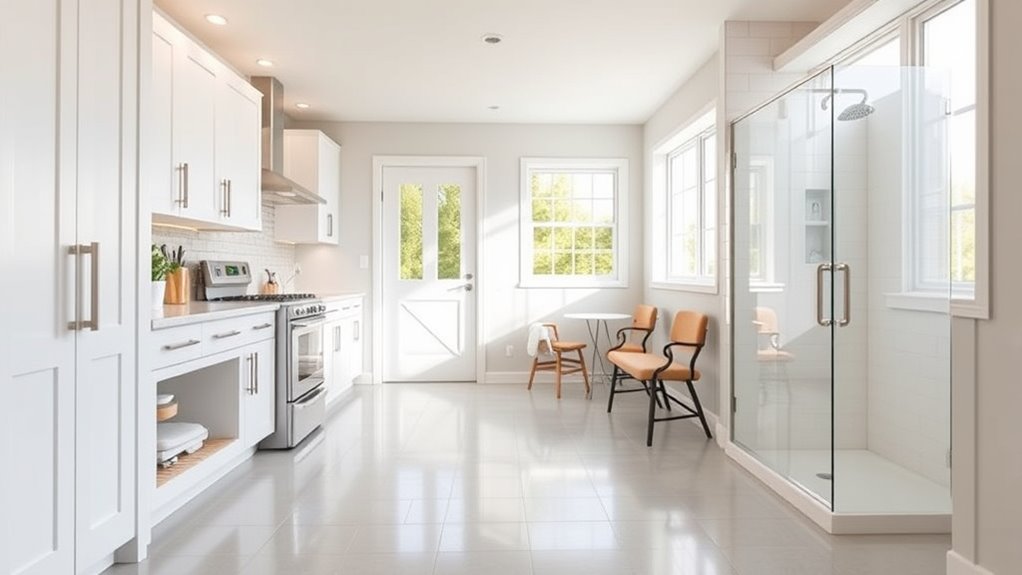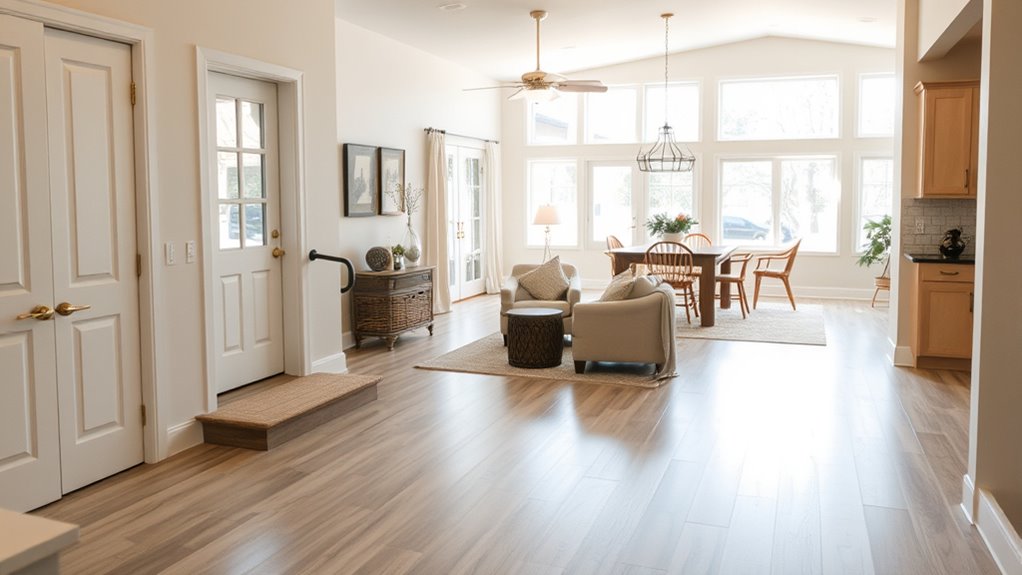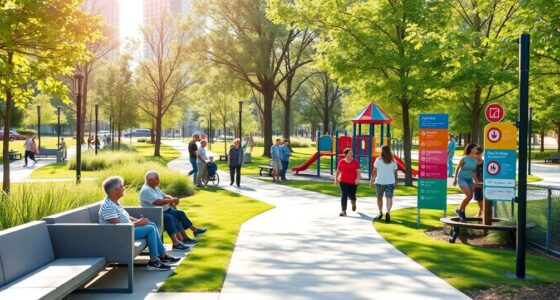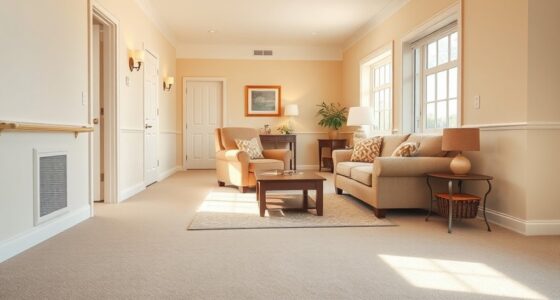When evaluating a home’s age-friendly features before buying, check for wide doorways, low-threshold entryways, and lever-style handles that improve accessibility. Look at bathroom safety features like grab bars and walk-in showers, and make certain good lighting, non-slip flooring, and sturdy handrails are in place. Also, assess exterior paths and potential for future modifications. Paying attention to these details helps ensure the home supports safety and independence now and in the future—you’ll uncover how to make a smart choice.
Key Takeaways
- Check for wide doorways, low-threshold entries, and lever handles to ensure easy access and mobility.
- Assess presence of safety features like grab bars, sturdy handrails, and non-slip flooring in bathrooms and stairs.
- Verify proper lighting, accessible switches, smoke detectors, and emergency systems on all home levels.
- Ensure exterior paths are level, paved, and have railings to support outdoor safety and independence.
- Consider future modifications, overall home layout, and affordability to support long-term age-friendly living.

As you consider making your home more suitable for aging in place, evaluating its age-friendly features becomes essential. Start by examining the accessible design of the house. Accessible design ensures that daily activities can be performed comfortably and safely, regardless of mobility or health changes. Look for features like wide doorways that can accommodate wheelchairs or walkers, low-threshold entryways that prevent tripping hazards, and lever-style door handles instead of knobs, which are easier to operate. Check if the kitchen counters are at a height that allows comfortable use from a seated or standing position, and see whether bathrooms have walk-in showers with seating or grab bars installed. These elements not only promote independence but also reduce the risk of accidents. Incorporating home safety modifications early on can help identify areas needing improvement and facilitate planning for future adjustments.
Evaluate your home’s accessible design features to promote safety and independence as you age.
Safety modifications are a vital part of evaluating a home’s age-friendliness. As you tour potential properties, pay close attention to potential hazards that could hinder safe living. Are there loose rugs or cords that could cause trips? Do staircases have sturdy handrails on both sides? Are there sufficient lighting fixtures, especially in hallways and stairwells, to prevent falls? Consider whether the home has non-slip flooring in bathrooms and kitchens, which greatly decreases slipping risks. It’s also wise to think about the placement of switches, outlets, and emergency systems. Are light switches easily reachable from a seated position? Is there a functioning smoke or carbon monoxide detector on every level? These safety features can make a substantial difference in emergency situations. Additionally, lighting control systems that can be easily operated from a seated position can enhance safety and convenience. Incorporating sound-based or voice-activated assistive technologies can further support independence as needs evolve.
While inspecting the home, don’t overlook exterior features. Is there a level, paved path leading to the entrance? Are railings installed along steps or ramps? These exterior safety modifications can enhance your confidence and independence outdoors. Additionally, assess the overall layout for potential future modifications. Is there space to add grab bars or handrails if needed? Can the home be easily adapted with minimal structural changes? Thinking ahead now saves you time and money later.
Furthermore, consider the potential benefits of gold investments or other accessible, stable assets that could enhance your financial security when evaluating long-term home affordability and safety features. Ultimately, evaluating a home’s age-friendly features involves more than just noting current conditions; it’s about envisioning how the space will serve you as your needs evolve. Focus on accessible design elements that promote ease of movement and independence, along with safety modifications that mitigate risks. By thoroughly assessing these features, you’ll be better equipped to choose a home that supports your lifestyle now and in the future.
Frequently Asked Questions
How Do I Assess the Safety of a Home’s Age-Friendly Features?
You should start by inspecting key safety features like grab bars, non-slip flooring, and adequate lighting. Check if the home has modern home automation systems that enhance safety, like smart alarms or emergency alerts. Also, assess energy efficiency, ensuring windows and insulation help maintain a safe, comfortable environment. Don’t forget to test accessibility features and look for potential hazards, making sure the home supports safe, independent living.
What Specific Features Should I Prioritize for Aging in Place?
Did you know 90% of seniors prefer to age in place? To make that happen, prioritize features like home automation for easy control of lights and thermostats, and universal design elements such as wide doorways, no-step entries, and lever handles. These features enhance safety and accessibility, allowing you to move comfortably and independently. Focus on these upgrades to create a supportive environment that adapts to your changing needs.
How Can I Modify an Older Home to Improve Age-Friendliness?
To make an older home more age-friendly, start with a home renovation focused on accessibility upgrades. You can widen doorways, add grab bars in bathrooms, and install stairlifts if needed. Consider replacing doorknobs with lever handles and ensuring floors are slip-resistant. These modifications help improve safety and mobility, making your space more comfortable and accessible as you age. Prioritize practical upgrades that support independence and reduce fall risks.
Are There Legal or Zoning Considerations for Age-Friendly Modifications?
You might think age-friendly modifications are straightforward, but zoning restrictions and legal compliance can complicate things. It’s crucial to investigate local regulations before making changes, as some modifications—like ramps or widened doorways—may require permits or violate zoning laws. To avoid future issues, consult your local planning department or a legal expert to ensure your upgrades meet all legal and zoning requirements, keeping your home safe and compliant.
What Maintenance Issues Are Common in Age-Friendly Homes?
You should watch out for common maintenance issues in age-friendly homes, especially during home renovation. Look for wear on grab bars, handrails, and non-slip flooring, which are crucial for accessibility standards. Check for plumbing or electrical concerns that might affect safety and functionality. Regular inspections help guarantee these features remain effective, and addressing potential problems early prevents costly repairs. Staying proactive maintains the home’s safety and comfort for years to come.
Conclusion
Once you evaluate a home’s age-friendly features, you’re making a smart choice for safety and comfort. Did you know that nearly 90% of seniors prefer aging in place? By choosing a home with accessible features now, you’re setting yourself up for independence and peace of mind in the future. Take the time to assess those details—your future self will thank you for it!









